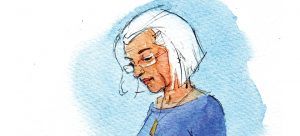
Birdwatch
The song of the white-throated sparrow heralds winter
By Susan Campbell
Here in central North Carolina, the winged harbinger of winter is the white-throated sparrow. After summering in the forests of the far north, this bold little bird breeds across Canada and in northern New England at higher elevations. Then it heads south for the winter, probably stopping off in your backyard. A medium-sized sparrow, it is anything but drab, with brown notes on its upper body and white below. Look for bold markings on the head. Pale stripes on the crown and a white throat patch are set off by gray feathers on the face. And to top it all off, white-throateds sport a yellow spot at the base of their stout bill.
Interestingly there are two color forms of this species: those with heads that are white-striped and those that are tan-striped. Both forms persist. While white-striped individuals are more aggressive during the breeding season, either type will breed with the other. Following courtship, females handle the nest-making, usually in a depression on the ground under a low-growing tree or shrub. However, should it, not surprisingly, fall victim to predators, the second nest may be placed on low branches.
If you have not spotted one of these birds, you almost certainly have heard their distinctive loud “seet” call emanating from thick vegetation. Their song, which can be heard even during cold weather, is a recognizable, liquid “oh sweet Canada.” (Others hear “old Sam Peabody.”) Since they tend to flock together, you are likely to encounter small groups along forest edges, farm fields, parks and suburban areas
These squatty sparrows actually have a broad diet. Although they primarily feed on a range of seeds during the winter months, their preference shifts during the year. In spring, they are more likely to seek out buds and flowers of fresh vegetation. Luckily, white-throateds love feeding stations, often in association with dark-eyed juncos, another bird of the high country.
White-throated sparrows do not walk or run but hop when on the ground. As they forage, they will forcefully scratch backward in leaf litter using both feet and pouncing on tasty bits that they uncover. And if you happen to look out of your window and see leaves taking flight, it is probably white-throated sparrows forcefully flicking aside dead leaves using their bills. In the winter months, pecking orders form within flocks with the more aggressive males dominating.
If you want to attract white-throated sparrows this winter, it is easy and inexpensive. Since they tend to stay low, scattering a seed mix in a cleared spot near shrubs or other thick vegetation is all it may take. White-throats will hop up onto a stump or low platform feeder as well. Easier yet, simply leave a portion of your yard unmowed until Spring and these predictable visitors may well turn up to take advantage of the resulting seeds that remain as the growing season winds down. OH
Susan would love to receive your wildlife sightings and photographs at
susan@ncaves.com.





